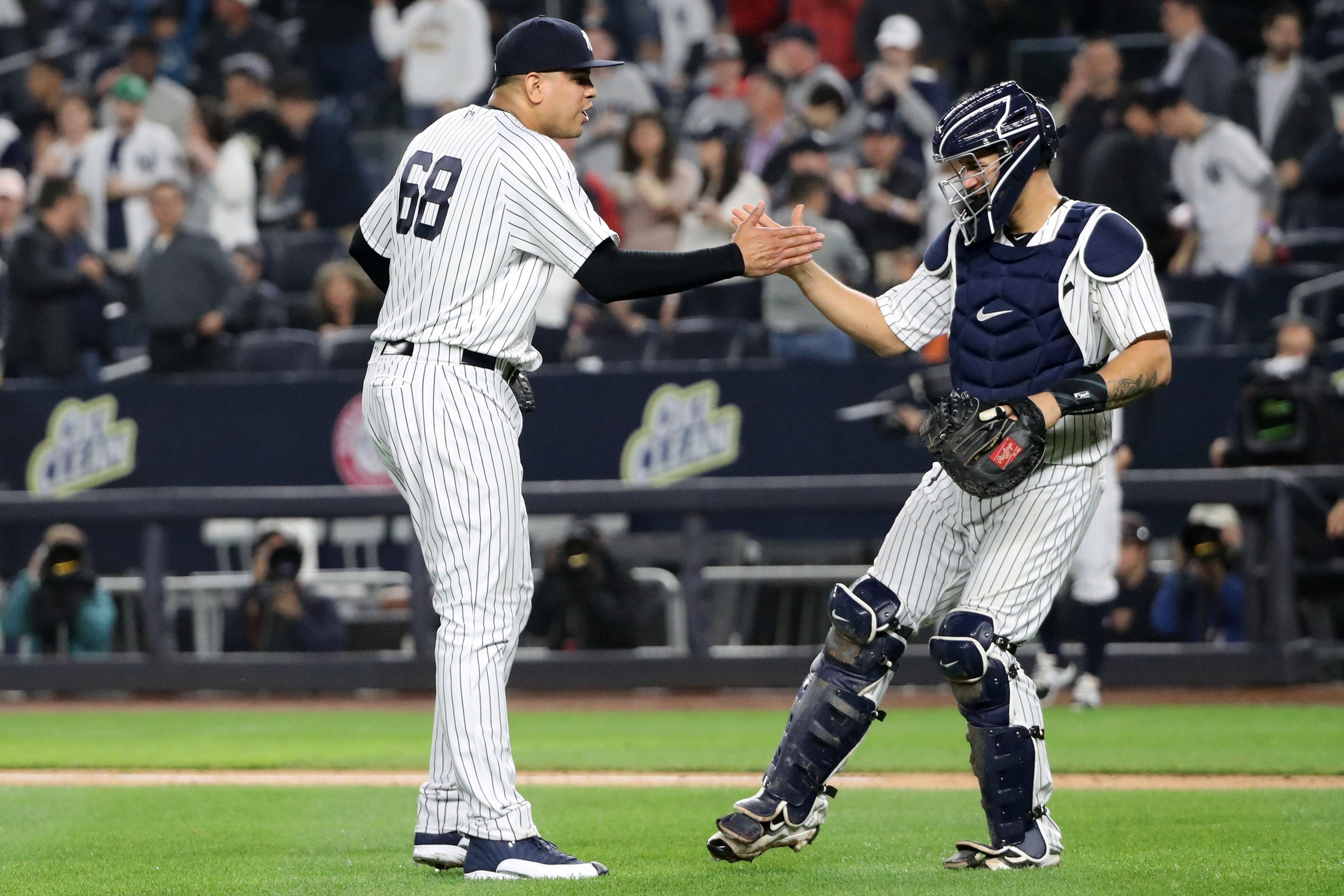Few teams have put together a trio of relievers as dominant as the Yankees’ group in the first half of the 2016 season. The Bombers signed Andrew Miller prior to 2015 and added Aroldis Chapman via trade to join incumbent relief ace Dellin Betances. The Betances-Miller-Chapman combination performed as advertised in 2016, as the Yankees were 19-2 in games in which all three pitchers appeared. While the Bombers traded away their lefty studs Chapman and Miller, prior to the 2016 deadline, they were able to resign Chapman to a long-term deal this winter.
As one half of the Yankees’ current late-inning tandem, Betances has been one of the most valuable relievers in baseball over the past three seasons. The New York native compiled a total PWARP of 8.59 from 2014-2016, highest among relievers with more than ninety innings pitched over that span. Betances also maintained an impressive 14.28 K/9, including a league-best 15.50 mark in 2016. However, the right-hander was subject to some bad luck in 2016, as his ERA and WHIP inflated while his DRA remained consistent with his career averages. Betances is on pace for a career-low workload in 2017, however, his ratio statistics such as his 16.10 K/9 and 0.73 ERA point to this being one of the best seasons of Betances’ young career.
| Season | ERA | WHIP | BABIP | DRA |
| 2014 | 1.40 | 0.78 | .241 | 1.73 |
| 2015 | 1.50 | 1.01 | .257 | 1.83 |
| 2016 | 3.08 | 1.12 | .353 | 1.79 |
(Data Provided by Baseball Prospectus)
In return for Aroldis Chapman, the Yankees netted their top prospect Gleyber Torres from the Chicago Cubs, a worthwhile haul for just three months of service from the most powerful reliever in baseball. To illustrate Chapman’s overwhelming velocity, in July of 2016, Brooks Baseball documented a Chapman fastball released at 105.85 mph, breaking his own record of 105.81. With an imposing fastball-slider combination, Chapman collected 105 saves over the past three seasons. In 2017, Chapman’s rotator cuff inflammation has elevated Betances into the closer role temporarily, however the Yankees hope to have their flamethrower back by early June.
The Yankees have two talented pitchers to anchor the backend of their bullpen this season. With a rejuvenated offense and playoff hopes, it is worth asking, how the Bombers’ eighth and ninth inning options compare to some of the more dominant bullpen arms of recent World Series championship teams.
2015 Kansas City Royals: Wade Davis and Kelvin Herrera
In 2015, the Royals pioneered a trend that has since been adopted by many other teams around the league – building a World Series roster around a versatile bullpen. The theme of the 2016 postseason was relief pitching after the Royals thrived with that same formula in 2015 and, due in part to the Royals’ success, three relief pitchers signed contracts of over $60 million this past offseason. Thus, the success of the Royals 2015 bullpen has changed the way teams build their rosters.
When closer Greg Holland was lost to injury in September of the 2015 season, Wade Davis and Kelvin Herrera were ready to fill the void. Davis held a 0.94 ERA and Herrera induced a low contact rate of 72.6%. Baffling opposing hitters for much of the 2015 season, Davis and Herrera combined for a PWARP of 3.9. The 2015 All-Stars pitched a total of nine innings in the World Series without allowing an earned run and with the aid of former first overall pick, Luke Hochevar, the backend of the Royals bullpen stifled the Mets on the way to their first World Series championship in thirty years.
2010 San Francisco Giants: Brian Wilson and Sergio Romo
In 2010, the Giants began their run of three World Series championships in five years. Closer Brian Wilson saved a league-best 48 games in an all-star campaign. Wilson added 6 more saves in the postseason without allowing a single run over 11.2 innings pitched. Set-up man Sergio Romo relied heavily on his slider in 2010, throwing it 43.71% of the time according to Brooks Baseball. The slider was extremely effective for Romo, as he induced a miniscule .171 batting average against that pitch.
Wilson and Romo paired with Jeremy Affeldt and the newly acquired Javier Lopez formed a formidable group on the Giants’ championship team. San Francisco retained most of this core throughout their subsequent World Series runs.
1996 New York Yankees: John Wetteland and Mariano Rivera
Turning back the clock a bit further in baseball history, we find one of the greatest Yankees bullpens of all time on the 1996 championship team. In his second and final season with the Yankees, closer John Wetteland saved 43 games with a 2.83 ERA. Wetteland earned World Series MVP honors that season after saving all four Yankee wins, allowing only one earned run. A set-up man at the time, Mariano Rivera burst onto the scene in 1996 and finished third in Cy Young Award voting. After struggling as a starter in his rookie 1995 season, the Yankees transitioned Rivera into a full-time reliever. Rivera often pitched multiple innings in the ’96 season, totaling 107.2 innings pitched over 61 relief appearances. In Rivera’s final season before taking over as the Yankees’ full-time closer he contributed a 2.98 PWARP, the highest among relievers in 1996. These two relievers were an unstoppable team and carried their success into the postseason.
The eighth and ninth inning pair of Betances and Chapman compare favorably to some of the more effective World Series bullpens in recent history, including arguably the best Yankees tandem of all time. Additionally, the ancillary bullpen arms of the 2017 Yankees have provided enough support for Betances and Chapman as Jonathan Holder, Tyler Clippard, and Adam Warren have all enjoyed early success. The Yankees possess a bullpen that is built to succeed in the postseason, and provided Chapman returns to full health, they rival any late-inning duo in recent history.
